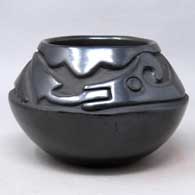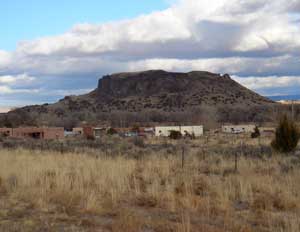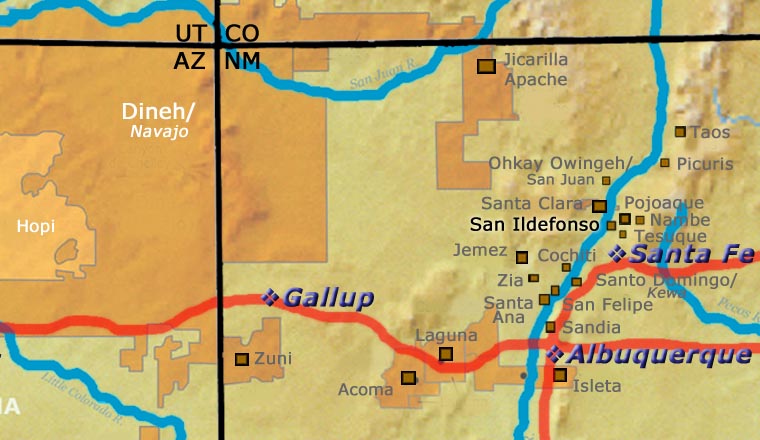
Juanita Gonzales
San Ildefonso
“My mother had a knack for saying the right thing at the right time.” - Adelphia Martinez, speaking of her mother, Juanita Gonzales
Juanita Gonzales was born Juanita Archuleta, at Taos Pueblo in 1909. She never learned much about making pottery growing up as she was much more interested in medicine and healing. There were only a few potters at Taos anyway. In her early 20s, she was working in a hospital when she met Louis “Wo-peen” Gonzales (1907-c.1990).
Louis was an easel painter, one of the first group of muralists and easel painters known as the San Ildefonso School. After his 1932 showing at the Boston Art Club, one critic commented, “In character they are as definitely and clearly defined as the hieroglyphic paintings of the ancient Egyptians - only in a different and finer way.” Another critic compared his work favorably to the fine line 16th century miniature paintings of Persia. Then Louis suffered a hunting accident and lost his right arm.
Juanita met him in the hospital and helped to nurse him through his recovery. They fell in love and were married in 1933. She moved to his home at San Ildefonso Pueblo and a couple years later, their daughter, Adelphia Gonzales Martinez, was born. Then Juanita began to learn how to make pottery by watching and working with her sister-in-law, Rose Gonzales, while Louis set about learning to paint again using his left arm.
That was also around the time Juanita and Louis “adopted” Lorenzo Gonzales and his sister, Crucita (the future Blue Corn). Lorenzo and Crucita's parents had died while they were away at the Indian boarding school in Santa Fe. Juanita and Louis watched over them when they came back to the pueblo in the summer. Those summers were also spent working together making pottery.
Juanita made black-on-black and redware jars, bowls, plates, wedding vases and figures, turtles and frogs mostly. She carved as many as she painted.
Juanita was multi-lingual. She was raised at Taos and grew up speaking Tiwa. When she married Louis, she moved to San Ildefonso and learned to speak Tewa. She and Louis both also spoke Spanish and English. In the 1970s Juanita decided to go back to school. She attended the College of Santa Fe and took courses centered around teaching Head Start, Home Enrichment and programs for the elderly. Her transcripts said she was an A and B student.
Juanita was a participant in the Santa Fe Indian Market and the New Mexico State Fair for more than 40 years. She participated in the Gallup InterTribal Ceremonial for more than 20 years and the Eight Northern Pueblos Arts & Crafts Show for more than a decade. For many of those years she shared her booth at Santa Fe with her daughter, Adelphia. Eventually age took its toll and she stopped participating in all events in 1981. Over the years she earned a number of First and Second Place ribbons from every venue where she participated in the juried competitions.
Juanita signed most of her pottery “Juanita Wo-peen.” Some is signed “Louis & Juanita.” Wo-peen was Louis' Tewa name, meaning: Medicine Mountain. At the time of his birth, the spiritual leaders of San Ildefonso emerged from their kiva and made a pilgrimage to Medicine Mountain. Louis served as Governor of San Ildefonso Pueblo in 1944-1945.
100 West San Francisco Street, Santa Fe, New Mexico 87501
(505) 986-1234 - www.andreafisherpottery.com - All Rights Reserved

San Ildefonso Pueblo
San Ildefonso Pueblo is located about twenty miles northwest of Santa Fe, New Mexico, mostly on the eastern bank of the Rio Grande. Although their ancestry has been traced to prehistoric pueblos in the Mesa Verde area, their most recent ancestral home is in the area of Bandelier National Monument, the prehistoric village of Tsankawi in particular. Tsankawi abuts the reservation on its northwest side.
A mission church was built in 1617 and named for San Ildefonso. Hence the name. Before that the village was called Powhoge, "where the water cuts through" (in Tewa). Today's pueblo was established as long ago as the 1300s. When the Spanish arrived in 1540, they estimated the village population at about 2,000.
That mission was destroyed during the Pueblo Revolt of 1680 and when Don Diego de Vargas returned to reclaim the San Ildefonso area in 1694, he found virtually all the Tewa people on top of nearby Black Mesa. After an extended siege the two sides negotiated a treaty and the people returned to their villages. However, the next 250 years were not good for them. The Spanish swine flu pandemic of 1918 reduced the pueblo's population to about 90. Their population has grown to more than 600 now but the only economic activity available on the pueblo involves creating art in one form or another. The only other work is off-pueblo. San Ildefonso's population is small compared to neighboring Santa Clara Pueblo, but the pueblo maintains its own religious traditions and ceremonial feast days.
San Ildefonso is most known for being the home of the most famous Pueblo Indian potter, Maria Martinez. Many other excellent potters from this pueblo have produced quality pottery, too, among them: Blue Corn, Tonita and Juan Roybal, Dora Tse Pe and Rose Gonzales. Of course the descendants of Maria Martinez are still important pillars of San Ildefonso's pottery tradition. Maria's influence reached far and wide, so far and wide that even Juan Quezada of the Mata Ortiz pottery renaissance in Chihuahua, Mexico, came to San Ildefonso to learn from her.
100 West San Francisco Street, Santa Fe, New Mexico 87501
(505) 986-1234 - www.andreafisherpottery.com - All Rights Reserved

